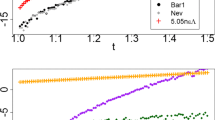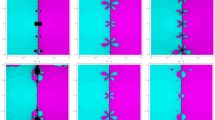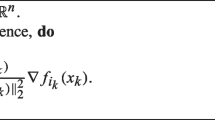Abstract
Sixty years ago, Butcher (Butcher Math. Soc. 3, 185–201 1963) characterized a natural tabulation of the order conditions for Runge–Kutta methods of order p as an isomorphism from the set of rooted trees having up to p nodes and provided examples of explicit and implicit methods of several orders. Within a few years, Fehlberg (Fehlberg 1968) derived pairs of explicit methods of successive orders that could be implemented efficiently by using the difference of each pair of estimates to control the local error. Unfortunately, Fehlberg’s pairs were deficient for quadrature problems. Subsequently, this author (Verner SIAM J. Numer. Anal. 15, 772–790 1978, Verner SIAM J. Numer. Anal. 16, 857–875 1979) derived parametric families of explicit Runge–Kutta pairs of increasing orders 6 to 9 that avoided this problem altogether. These, and most known explicit methods, have been derived by exploiting certain “simplifying conditions” suggested by Butcher (Butcher Math. Soc. 3, 185–201 1963, Butcher 1987 [pp. 194 f.]) that imposed constraints on subsets of the coefficients and thereby simplified the solution of the order conditions for moderate to high-order methods. “RK-Test-21”, a MAPLE program developed recently by Butcher (Butcher 2021), was applied to derive known 13-stage pairs of orders 7 and 8. Unexpectedly, results of this application revealed the existence of some previously unknown pairs—i.e., some with the correct orders that satisfied most, but not all, of the previously known simplifying conditions. This present study develops formulas for directly computing exact coefficients of these new pairs together with others lying within this new parametric family of (13,7-8) pairs. While the best of these new pairs falls short of the best of pairs already known, the properties discovered might be utilized to precisely characterize recently reported higher-order methods found using other approaches by Khashin (Khashin 2009) and Zhang (Zhang 2019) and possibly lead to finding other Runge–Kutta and related yet unknown methods.
Similar content being viewed by others
Data availability
The MAPLE computing environment was made available to the author from Simon Fraser University, Canada.
References
Butcher, J.C.: Coefficients for the study of Runge-Kutta integration processes. J. Austral. Math. Soc. 3, 185–201 (1963)
Butcher, J.C.: The numerical analysis of ordinary differential equations. Runge–Kutta and general linear equations. John Wiley & Sons , pp 512 (1987)
Butcher, J.C.: B-Series: an algebraic analysis of numerical methods. Springer/Verlag , pp 310 (2021)
Butcher, J.C.: RK-Test-21: a Runge–Kutta order test. (Web page of J.C. Butcher) (2021) http://jcbutcher.com/node/102
Cooper, G.J., Verner, J.H.: Some explicit Runge-Kutta methods of high order: SIAM. J. Numer. Anal. 9, 389–405 (1972)
Curtis, A.R.: An eighth order Runge-Kutta process with eleven function evaluations per step: Numer. Math. 16, 268–277 (1970)
Fehlberg, E.: Classical fifth-, sixth-, seventh-, and eighth-order formulas with stepsize control: NASA Tech. Rep. NASA 2.7, George C. Marshall Space Flight Center, Huntsville (1968)
Hairer, E., Nørsett, S.P., and Wanner, G.: Solving ordinary differential equations I, Nonsfiff problems, second revised edition. Springer Series in Computational Mathematics 8. Springer–Verlag, Berlin (1993)
Khashin, S. : A symbolic-numeric approach to the solution of the Butcher equations. (2009) http://www.math.ualberta.ca/ami/CAMQ/table_of_content/vol_17/17_3g.htm
Sharp, P.W., Smart, E.: Explicit Runge-Kutta pairs with one more derivative evaluation than the minimum. SIAM J. Sci. Comput. 14, 338–348 (1993)
Verner, J.H.: Explicit Runge-Kutta methods with estimates of the local truncation error. SIAM J. Numer. Anal. 15, 772–790 (1978)
Verner, J.H.: Families of imbedded Runge-Kutta methods. SIAM J. Numer. Anal. 16, 857–875 (1979)
Verner, J.H.: Numerically optimal Runge-Kutta pairs with interpolants. Numer. Algor. 53, 383–396 (2010). https://doi.org/10.1007/s11075-009-9290-3
Zhang, D.K.: Discovering new Runge-Kutta methods using unstructured numerical search. Undergraduate Thesis, Vanderbuilt University, Nashville, Tennessee. (2019) arXiv:1911.00318
Acknowledgements
“RK-Test-21” is an extension of an APL program written on January 1, 1970, jointly by J.C. Butcher and the author to test the order of Runge–Kutta methods; the extension was designed and developed by J.C. Butcher in 2021 to allow direct solution of the Runge–Kutta order conditions by MAPLE. The author thanks J.C. Butcher for providing a copy of the MAPLE code “RK-Test-21” for use in the development of the research in this article and for his encouragement and support during the development of this research.
Author information
Authors and Affiliations
Contributions
The research in this article was developed completely by the author, and the author wrote the complete manuscript and used the MAPLE computing environment with “RK-Test-21” and other code developed and written by the author to compute coefficients in Tables 3, 5, and 6. The author also tabulated the numbers of trees within Table 2.
Corresponding author
Ethics declarations
Ethical approval
Not applicable
Conflict of interest
The author declares no competing interests.
Additional information
Dedicated to Professor J.C. Butcher in celebration of his ninetieth birthday.
Publisher's Note
Springer Nature remains neutral with regard to jurisdictional claims in published maps and institutional affiliations.
Appendices
Appendix
This appendix displays an example of a new nullspace (13,7-8) explicit Runge–Kutta pair. The final line in Table 4 states the properties of a near-optimal new pair found. For that pair, the nodes are \({{\textbf {c}}}= {\{0,1/1000,1/9,1/6},5/12,1/2,5/6,\) \({1/6,2/3,19/25,21/25,1,1\}}\), \(a_{7,6}=7/3,\) and \(a_{8,7}=5/267\). Here, we report a nearby method that has \(LTE_2=10^{-5}\), \(D=70.386\) and interval of absolute stability of the method of order eight equal to \((-4.567,0]\). To represent this pair, we first state the pair for which \(a_{7,6}=a_{8,7}=0\) in Table 5.
A different pair arises for almost every choice of \(a_{7,6}\) and \(a_{8,7}\) although a few discrete choices fail to yield a pair as a result of singularities occurring on the application of the algorithm to derive nullspace pairs. For nodes in Table 5, and almost any choice of \(a_{7,6},\ a_{8,7}\), a more general pair is obtained by computing the matrix \(\mathbf {\widehat{A}}\) using the following vectors in formula (17):
-
Column \(C1=[0,0,0,0,0,0,1,-\frac{1}{6},-\frac{343}{243},-\frac{2058}{3125},\frac{343}{1944},\frac{5831}{240},\frac{686}{195}]\)
-
Row \(R1=[-\frac{2}{5},0,0,1,-\frac{8}{5},1,0,0,0,0,0,0,0]\)
-
Column \(C2=[0,0,0,0,0,0,0,1,\frac{2744}{1215},\frac{24696}{78125},-\frac{343}{9720},\frac{5831}{200},\frac{1372}{325}]\)
-
Row \(R2=[\frac{1073}{343},0,0,-\frac{3330}{343},\frac{8352}{343},-\frac{6438}{343},1,0,0,0,0,0,0]\)
For a nearly optimal pair with these nodes, choose \(a_{7,6}=27/10,\ a_{8,7}=1/72\) in formula (17).
An optimal pair
In contrast to the previous pair, the nodes may be changed to optimize the pair—in the sense that the 2-norm of the local truncation error coefficient discrepancies of the higher-order method is minimized. The final line in Table 4 states the properties of this pair. Slight improvements on this pair are possible by reducing \(c_2\) towards zero, but such improvements are marginal. Table 6 records coefficients of \(\{{\textbf {b}},\ \varvec{\widehat{b}},\ {\textbf {A}},\ {\textbf {c}} \}\) when \(a_{7,6}=0\) and \(a_{8,7}=0\) for the optimal pair.
A more general pair is obtained when matrix \(\mathbf {\widehat{A}}\) is computed with almost any values of \(a_{7,6}\) and \(a_{8,7}\) using the four following vectors in (17):
-
Column \(C1=[0,0,0,0,0,0,1,-\frac{1}{5},-8,-\frac{13844844}{1953125},\frac{4279716}{1953125},-\frac{54108}{2315},\frac{3564}{1105}]\)
-
Row \(R1=[-\frac{2}{5},0,0,1,-\frac{8}{5},1,0,0,0,0,0,0,0]\)
-
Column \(C2=[0,0,0,0,0,0,0,1,10,\frac{38073321}{9765625},\frac{1069929}{9765625},-\frac{13527}{463},\frac{891}{221}]\)
-
Row \(R2=[\frac{8}{3},0,0,-\frac{25}{3},\frac{64}{3},-\frac{50}{3},1,0,0,0,0,0,0]\)
In particular, we get a nearly optimal pair for the choices of \(a_{7,6}=7/3\) and \(a_{8,7}=5/267 \) using these vectors in (17).
Rights and permissions
Springer Nature or its licensor (e.g. a society or other partner) holds exclusive rights to this article under a publishing agreement with the author(s) or other rightsholder(s); author self-archiving of the accepted manuscript version of this article is solely governed by the terms of such publishing agreement and applicable law.
About this article
Cite this article
Verner, J.H. Nullspaces yield new explicit Runge–Kutta pairs. Numer Algor (2024). https://doi.org/10.1007/s11075-023-01731-6
Received:
Accepted:
Published:
DOI: https://doi.org/10.1007/s11075-023-01731-6




